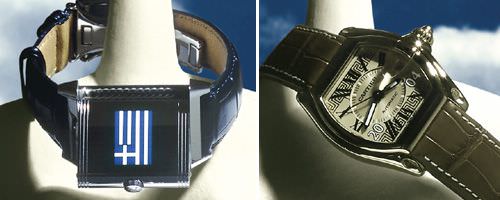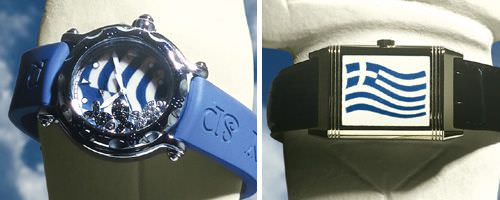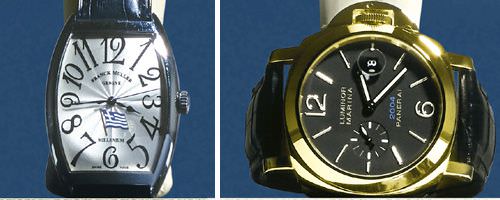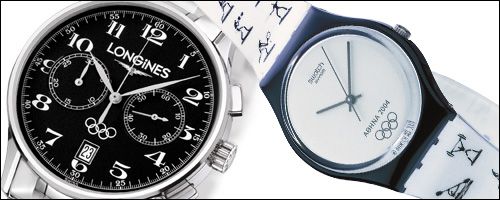It is impressive to think that although the notion of time has been present in our lives for thousands of years, the wristwatch and with it the notion of personal time, have been around for only a century. Furthermore, while a watch’s precision has always been the key evaluating factor up to now, today most buyers focus on uniqueness as the most important criterion.
However strange or funny it may sound, both the person willing to spend millions of euros in order to acquire a Patek Philippe Calibre 89 and those who find it extremely hip to buy a fake Panerai instead of the original (as their friends did!), happen to be seeking something unique. The ideal, of course, is when this unique quality comes to concern us in a more particular and personal way. During an age when precise time is omnipresent, one needs a watch that not only acts as a worthy representative that reflects your personality, but goes well beyond.
Limited editions for Greece
For all these reasons most companies have been keen to explore the possibilities offered by limited editions. What’s more, while globalization provides the means to reach the hearts and souls of myriads of people worldwide, under a common conceptual roof, local idiosyncrasies still exist and can be brought into the limelight through originally designed and specially conceived limited editions. Our subject, of course, pertains to some of the most interesting limited editions that were produced as a result, in great part, of Athens staging the 2004 Olympic Games. Several amongst these are exclusive to the Greek market, a fact which surely increases their value as a collector’s item.
In 1999, at a time when Franck Muller was extremely coveted in Greece, in par with most international markets, Franck the star accepted Kessaris’s (Franck Muller’s exclusive representative for Greece) proposal, and created 100 watches in the classical Cintree Curvex shape, with a wavy blue and white enamelled Greek flag on the dial. The model was produced in steel (90 pieces) and the three colours of gold (10 pieces in total). The series was complemented with a watch in platinum, featuring a transparent caseback. This particular model is truly rare collector’s item.
The 100 watches in steel and gold, respectively, presented in a single display window, were sold literally in a blink, at the opening of the Very Important Watches Millennium show, which took place in November 1999, at the Athens Hilton. The model has been out of circulation since then.

Large Reverso by Jaeger-LeCoultre and Roadster by Cartier

Happy Hellas by Chopard and Reverso by Jaeger-LeCoultre

Cintree Curvex by Franck Muller and Luminor by Panerai
National Flag editions
Jaeger-LeCoultre’s Reverso, for many the most important watch of all time, presents in itself many characteristics associated with Greece. Its dimensions, for one, are based on the golden mean. At the same time, the typical ribbed carvings at the top and bottom of the case have the same scale as the columns of the Parthenon. Needless to say, a limited edition for local collectors featuring the Greek national flag, was to be expected. A few months ago, a stainless steel Reverso, the caseback featuring a Greek flag in enamel, was presented to the public. 46 pieces were made, a number equal to that of the Parthenon’s columns. The dial was evidently in blue and white, reflecting the colours of the Greek flag. The leather strap came in blue, too. Another unique Reverso was also made, in yellow gold this time, featuring a bigger Greek flag, also in enamel.
As for Cartier, their Greek collector’s edition was based on the Roadster model, itself a successfully daring move. The special Greek edition toyed with the 2004 motif, an ingenious idea proposed by the local Richemont office: the 8 and 4 positions of the dial were put in play, forming the magical number, 2004! The watch has a blue leather strap, and the Greek flag is engraved on the caseback. It is manufactured in a limited edition of 177 pieces in stainless steel as a tribute to the number of years since the modern Greek state formed its first government. Fifty more watches were made in gold, with a striking meander motif on the dial.
Rugged is ‘in’
Another international tendency present in the Greek market are watches in the oversized category. Let’s not forget that Panerai started this international trend, which is currently the easy design solution for many companies. If only five years ago a 44mm diameter Panerai seemed overbearingly huge, today it is easily worn even, and especially, by women. In many cases, oversized watches have overshadowed more important and discreetly designed ones.
In the local men’s market, buyers more easily appreciate brawny, ‘rugged’ sports watches, rather than the delicate and intricately-made Haute Horlogerie masterpieces. Panerai’s success in Greece was therefore evident. It is truly one of the few companies where the public’s demand is overwhelming. The watch that Panerai produced especially for Greece is a take on the well known and impressive Luminor model, with a very slight difference: it features the number 2004 in blue just below the centre of the dial, with the highly esteemed local representative’s logo, Kessaris, engraved on the back. Fifty pieces in steel and ten in gold were made.
Chopard presented the Happy Hellas model (Hellas is the official name of Greece), based on the very popular Happy Sport watch: The dial comes in mother-of-pearl and features a Greek flag, while the idea of a few apparently floating ‘jewel-fishes’ has been borrowed from the Happy Beach model. There is also an edition where the bezel is set with brilliants. Each edition is in stainless steel and is limited to 100 pieces.
And now for something different
Apart from the majors, even small, independent watchmakers have fiddled with the Greek ideal. Wishing to honour the Greek public that eagerly anticipated his first appearance at the Very Important Watches Millennium show in 1999, the highly creative Svend Andersen personally expressed to me an idea about making an erotic timepiece, inspired by Ancient Greece. I thus sent him several illustrated books and on the same day he received them, he faxed me an erotic scene that he had conceived, based on the drawings from an ancient amphora. The watch was first shown in Greece and even though it isn’t a limited edition, it happens to be a particularly beautiful and uncommon creation.
On a different scale now, we all know that there were no corporate sponsors, much less official timekeepers at the 1896 Olympics, held in Athens. Time was simply kept with grand old Longines stopwatches. During the past century, Longines was of course the official timekeeper for the Olympic Games on many occasions. To celebrate its 125 years of participation in sports events timekeeping, Longines created the Olympic Collection.
Corum’s Bubble is also bracing itself for a Greek edition, as a prototype design clearly shows.

Olympic watch by Swatch and Olympic Collection by Longines
Last but not least, Swatch is certainly the company that, like no other, put special, themed editions on the map. Among the thousands of different models, themes relating to Greece were always present, due to the love that Mr. Nicolas Hayek’s nurtures for this country. One may distinguish the models with Greek names, made for the Atlanta Olympics, the Avaton model, inspired by the Holy Mount Athos, and, more recently, the Swatch model featuring a discus thrower, or discobolus, if your prefer. For the forthcoming Athens Games, Swatch produced dozens of new models.
Constanin Stikas is the founder and President of Minimal, the company that organizes the successful Athens-based Very Important Watches™ show, which is highly regarded well beyond the borders of Greece.






